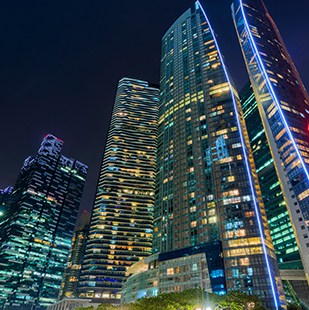This website uses cookies so that we can provide you with the best user experience possible. Cookie information is stored in your browser and performs functions such as recognising you when you return to our website and helping our team to understand which sections of the website you find most interesting and useful.
Lighting for the future.
Thanks to the participation of our consortium, the DLC’s LED lighting program is home to the largest and most influential list of high-performing LED luminaires and commercial lighting products in the world. We work in tandem with energy efficiency programs to improve both the energy savings potential and quality of light in the built environment. The SSL (LED) Qualified Products List improves both consumer confidence and sustainability of the LED lighting market as a whole through well-researched criteria for efficiency and quality created by our expert team and with input from our stakeholders. Our rigorous vetting and review process to qualify for listing creates trust.


70%
increase in average efficacy of qualified LED products since beginning the program in 2011
SSL Technical Requirements
SSL Technical Requirements V5.1 is the currently active DLC Technical Requirements for commercial and industrial LED lighting products. For more guidance on submitting products under SSL V5.1, see the V5.0 & V5.1 Manufacturer and Industry Guidance. V5.1 contains new quality of light requirements, including spectral quality and glare, and new controllability requirements.
| Version | Status | Effective Date | Update By | Delist Date | Documentation |
|---|---|---|---|---|---|
| ACTIVE | Jul 1, 2020 | Apr 15, 2022 | – | Download PDF | |
| DELISTED | Feb 18, 2020 | Jan 31, 2021 | Jun 30, 2022 | Download PDF | |
| DELISTED | Oct 18, 2018 | Nov 15, 2020 | Feb 28, 2021 | Download PDF |
Upcoming Updates to SSL Technical Requirements
The DLC is planning updates to the SSL Technical Requirements. Originally planned for two phased updates, feedback received has determined that a single update as V6.0 would be less disruptive and provide the most value. SSL V6.0 represents a major update with an efficacy increase and associated delisting. It also includes proposed updates that support better controls information, outdoor lighting that mitigates light pollution, non-white light products, solar powered products, sustainability and more.
The update is currently in the research and development phase, and therefore does not have release dates set yet. The DLC will release the update as a draft, and will go through the same stakeholder input process that all DLC policies go through, giving our users ample opportunity to react and provide comments.
Possible items being considered for inclusion in the Technical Requirements are described below. This is an evolving list and while we are looking for input on these topics, we are also interested in gathering feedback on other topic areas. Please note that all proposed updates are subject to change based on DLC research and user feedback, and sufficient notice will be provided before the DLC releases the draft policy for comment and implementation.
Changes under consideration:
- – Clarifications and improvements to the color tuning policy, including new required information for color tunable products.
- – Allow submitters to report form factor and mounting data for their products.
- – Convert many specialty primary use designations (PUDs) into regular PUDs.
- – Accept 1800K and 2000K outdoor lighting products that comply with the forthcoming ANSI/NEMA C78.377 standard.
- – Streamline the outdoor lighting/LUNA application process to ease testing burden for product families.
- – Introduce support for solar products by including optional reported fields for solar panel and battery component information
- – Introduce the topic of lifecycle sustainability by allowing submitters to optionally report their product life cycle analyses (LCAs), environmental product declarations (EPDs), materials lists, and/or other sustainability information along with the standards or certification bodies these reports comply with.
- – Efficacy allowances as trade offs for products that meet certain thresholds for reduction in embodied carbon or toxicity, better materials, recyclability, and more.
- – Restructure of controls information on the SSL QPL to more clearly communicate the controls options that are available on a given product and help clarify discussions around lighting control communication protocols, interoperability, and capabilities. This new framework will also allow the DLC to articulate data connections between the SSL and NLC QPLs.
- – Reorganize and display field-adjustable product features and information in a clearer format.
- – Required reporting of certain quality of light features such as standardized flicker and color maintenance metrics.
- – Increased efficacy thresholds determined from current QPL and market statistics.
- – New primary use designations based on Member demand and requests from manufacturers.
- – Criteria for listing non-white light outdoor products (e.g. pc-amber, de-amber, and red spectra).
- – Lower maximum CCT threshold to align outdoor fixture requirements with the DLC’s mission to reduce light pollution (this comes with some potential exceptions, including sports lighting).
- – In-luminaire battery performance reporting to support load shifting with outdoor lighting fixtures.
- – Improvements to product lifetime reporting requirements to help lighting decision makers understand the useful lifetime of lighting products being installed.
- – New dual sourcing requirement pathways for manufacturers to more easily communicate where dual sourcing is occurring for their products and to show performance equivalence at the luminaire level.
- – Collection and display of detailed information on product availability/compatibility with NLC listed systems to eliminate controls-focused wildcards in model numbers and enable correlation between SSL and NLC QPL records.
- – Additional reporting on the QPL for existing metrics (e.g., the QPL could display UGR values, TM-30 Color Vector Graphics, or other standardized metrics or performance information).
As noted above, all proposed updates are subject to change based on DLC research and user feedback, and sufficient notice will be provided before the DLC releases the draft policy for comment and implementation. Please provide feedback to info@designlights.org.
© 2023 DesignLights Consortium. The DesignLights Consortium is a project of Efficiency Forward, Inc., a non-profit 501(c)3 organization. Privacy Policy Terms of Use



